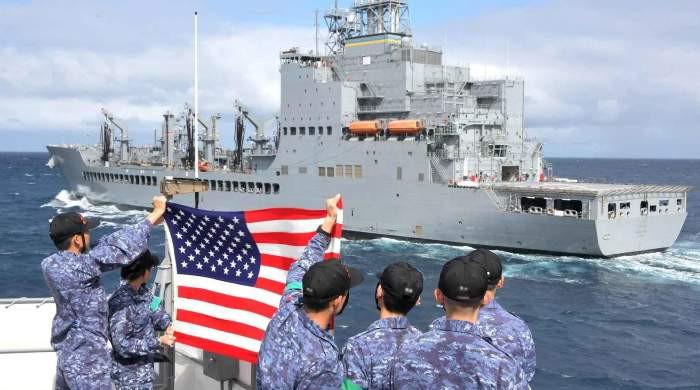New York: During an American naval test off the Californian coast last month, which was designed to present the best independent pentagon drone boats, a ship stopped unexpectedly.
While the officials rushed to repair a software problem, another drone ship crashed in the starboard side of the boat, jumped on the deck and crashed in the water – an incident captured in videos obtained by Reuters.
The uninformed episode, which involved two ships built by American defense technology technologies, Saronic and Blacksea technologies, is one of a series of recent setbacks in the push of the Pentagon to build a fleet of autonomous ships, according to a dozen people familiar with the program.
A few weeks earlier, during a separate naval test, the captain of a support boat was thrown into the water after another autonomous blacksea ship which he suddenly towed, capsizing the support boat, according to four people familiar with the issue. The captain was rescued and refused medical care. The incident was reported for the first time by Defense Scoop.
The two incidents arose from a combination of software failures and human error, including communication failures between on -board systems and external autonomous software, according to a person with direct knowledge of the case, which requested anonymity to share sensitive information.
The navy, Saronique and Blacksea refused to comment on the incidents.
The videos showing the drone accident were verified by two sources of Reuters, the matching field with the landscape, the name ID Garc-096 and the structure of the correspondence files of the Global Autonomous Boat Recognous Craft (GARC).
The American military leaders, seeing the disproportionate impact of maritime drones in the Ukraine War, said on several occasions that they needed autonomous swarms of air and sea drones to hinder a potential China advance through the Taiwan Strait. Taiwan himself began to acquire his maritime drones.
Drons under development in Ukraine, which often resemble speed boats without seats, and are able to transport weapons, explosives and surveillance equipment, are mainly remote -controlled and cost nearly $ 250,000 – which makes them optimal for suicide bomber missions which have actually neutralized the Russian Black Sea fleet.
The United States, on the other hand, aim to build an autonomous naval fleet which can move in swarms and without human control – a more ambitious task at a higher price; Up to a few million dollars per boat at speed.
The recent test failures highlight the challenges faced by naval efforts to deploy emerging technologies, said Bryan Clark, an autonomous war expert at the Hudson Institute. He will have to adapt his “tactics because she understands better what systems can do and what they cannot do”.
But the problems of the navy will be beyond operating the boats: its unit of acquisition of autonomous maritime drones was also shaken by the dismissal of its best admiral, and a senior official of the Pentagon expressed his concerns concerning the program during a frank meeting with the brass of the navy last month, found Reuters.
Since the most recent incident, the Pentagon Defense Innovation Unit (DIU), which had acquired the technology for tests, has indefinitely interrupted a contract worth almost $ 20 million with L3harris, one of the companies providing autonomous software used to control some of the ships, according to two familiar people with the problem.
The Pentagon did not answer questions about the cause of accidents or the L3harris in break contract, which has not been reported before.
A spokesperson for the Pentagon said that he had carried out drone tests as part of a “competitive and iterative approach, between operators and industry”.
L3harris refused to comment on the contract and asked questions to the IUD. The IUD refused to comment.
“L3harris is behind the safety, integrity and capacity of our autonomy control and control product,” said Toby Magsig, who oversees L3harris’s autonomous software products.
Sea drones
To accelerate its drone efforts, the Pentagon in 2023 launched the $ 1 billion replicators’ program, by which branches like the US Navy and the IUD planned to acquire thousands of air and sea drones, as well as the software to control them. The first systems in this program should be announced this month.
The Navy has hired at least $ 160 million in Blacksea, which produces dozens of its world’s autonomous recognition worldwide boats, according to the supply archives.
Saronic, which was recently estimated at $ 4 billion in a round of funding supported by Andreessen Horowitz and 8VC, made the Corsair competitive marine drone, but has not yet announced a major contract. Federal purchasing files show that the company has generated at least $ 20 million from prototype agreements.
“These systems will play an essential role in the future of the naval war by extending the scope of the fleet, improving the awareness of the situation and increasing the effectiveness of the fight,” said the acting chief of naval operations, Jim Kilby, during a visit to the installation of BlackSea in June.
Navy “
Since returning to the office, President Donald Trump has made Fielding Swarms of Drones a superior military priority. Trump’s “Big Beautiful Bill”, adopted last month, included nearly $ 5 billion for maritime autonomous systems.
But, so far, the approach of the navy has been faced with skepticism under the new administration.
In April, the naval drone boats supply unit – known as the executive program of unmanned program and small fighters (PEO USC) – presented a successful demonstration of the software used to control Blacksea ships in an article on Linkedin, greeting it as “a major step in the progress of #Maritime Automy”.
In response, Colin Carroll, then head of the Deputy Secretary of Defense, Steven Feinberg, suggested that the program reproduced other efforts within the Pentagon. “I have the feeling that there are changes in the future of this program,” he replied to Post LinkedIn. Carroll, which is no longer with the Pentagon, refused to comment more.
The PEO USC has recently been reviewed, according to four people familiar with the issue, due to a set of reverse, and could be restructured or closed.
This occurs two months after the navy said that she had dismissed the head of unity, the counterattack Kevin Smith, due to a loss of confidence in his direction after the Inspector General Naval confirmed a complaint against him. Reuters could not contact Smith.
During a meeting last month, Feinberg has toasted naval officials about their capacities of autonomous ships, including those implemented by the USC PEO, according to three people informed of the meeting. Feinberg was not impressed by some of the capacities acquired by the navy and wondered if they were profitable, people said.
A spokesperson for the Pentagon said: “We are not going to comment on private internal meetings” and asked questions about PEO USC to the navy.
The navy refused to comment on the meeting or the acquisition unit being examined. The spokesperson Timothy Hawkins said that the PEO USC maintains its mission, including its role as acquisition authority for maintenance and modernization of without pilot maritime systems.
The turmoil comes as naval manufacturers and software suppliers embody to secure even more important autonomous maritime projects, such as unmanned submarines and freight carriers.
Last week, the PEO USC began to accept proposals so that the profession of modular attack surface acquires average and large ships capable of transporting containers, surveillance equipment and making strikes.
TX HAMMES, an expert in autonomous arms and scholarship holder of the Atlantic Council, said that the navy was in unexplored waters, trying to revise decades of high -speed tradition.
“You have a system that is used to building great things, taking years to make a decision, and now suddenly, you ask them to move quickly,” he said.




